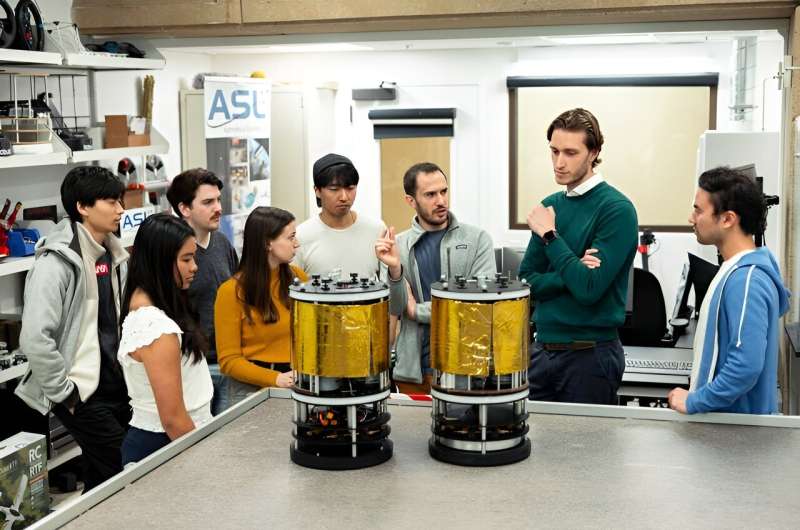Space travel is complex, expensive, and risky. Great sums and valuable payloads are on the line every time one spacecraft docks with another. One slip and a billion-dollar mission could be lost. Aerospace engineers believe that autonomous control, like the sort guiding many cars down the road today, could vastly improve mission safety, but the complexity of the mathematics required for error-free certainty is beyond anything on-board computers can currently handle.
In a new paper presented at the IEEE Aerospace Conference in March 2024 and published on the preprint server arXiv, a team of aerospace engineers at Stanford University reported using AI to speed the planning of optimal and safe trajectories between two or more docking spacecraft. They call it ART—the Autonomous Rendezvous Transformer—and they say it is the first step to an era of safer and trustworthy self-guided space travel.
Hail CAESAR
In autonomous control, the number of possible outcomes is massive. With no room for error, they are essentially open-ended.
“Trajectory optimization is a very old topic. It has been around since the 1960s, but it is difficult when you try to match the performance requirements and rigid safety guarantees necessary for autonomous space travel within the parameters of traditional computational approaches,” said Marco Pavone, an associate professor of aeronautics and astronautics and co-director of the new Stanford Center for AEroSpace Autonomy Research (CAESAR).
“In space, for example, you have to deal with constraints that you typically do not have on the Earth, like, for example, pointing at the stars in order to maintain orientation. These translate to mathematical complexity.”
“For autonomy to work without fail billions of miles away in space, we have to do it in a way that on-board computers can handle,” added Simone D’Amico, an associate professor of aeronautics and astronautics and fellow co-director of CAESAR. “AI is helping us manage the complexity and delivering the accuracy needed to ensure mission safety, in a computationally efficient way.”
CAESAR is a collaboration between industry, academia, and government that brings together the expertise of Pavone’s Autonomous Systems Lab and D’Amico’s Space Rendezvous Lab. The Autonomous Systems Lab develops methodologies for the analysis, design, and control of autonomous systems—cars, aircraft, and of course, spacecraft.
The Space Rendezvous Lab performs fundamental and applied research to enable future distributed space systems whereby two or more spacecraft collaborate autonomously to accomplish objectives otherwise very difficult for a single system, including flying in formation, rendezvous and docking, swarm behaviors, constellations, and many others. The lab is planning a launch workshop for May 2024.

A warm start
The Autonomous Rendezvous Transformer is a trajectory optimization framework that leverages the massive benefits of AI without compromising on the safety assurances needed for reliable deployment in space. At its core, ART involves integrating AI-based methods into the traditional pipeline for trajectory optimization, using AI to rapidly generate high-quality trajectory candidates as input for conventional trajectory optimization algorithms.
The researchers refer to the AI suggestions as a “warm start” to the optimization problem and show how this is crucial to obtain substantial computational speed-ups without compromising on safety.
“One of the big challenges in this field is that we have so far needed ‘ground in the loop’ approaches—you have to communicate things to the ground where supercomputers calculate the trajectories and then we upload commands back to the satellite,” explains Tommaso Guffanti, a postdoctoral fellow in D’Amico’s lab and first author of the paper introducing the Autonomous Rendezvous Transformer.
“And in this context, our paper is exciting, I think, for including artificial intelligence components in traditional guidance, navigation, and control pipeline to make these rendezvous smoother, faster, more fuel efficient, and safer.”
Next frontiers
ART is not the first model to bring AI to the challenge of space flight, but in tests in a terrestrial lab setting, ART outperformed other machine learning-based architectures. Transformer models, like ART, are a subset of high-capacity neural network models that got their start with large language models, like those used by chatbots. The same AI architecture is extremely efficient in parsing, not just words, but many other types of data such as images, audio, and now, trajectories.
“Transformers can be applied to understand the current state of a spacecraft, its controls, and maneuvers that we wish to plan,” Daniele Gammelli, a postdoctoral fellow in Pavone’s lab, and also a co-author on the ART paper. “These large transformer models are extremely capable at generating high-quality sequences of data.”
The next frontier in their research is to further develop ART and then test it in the realistic experimental environment made possible by CAESAR. If ART can pass CAESAR’s high bar, the researchers can be confident that it’s ready for testing in real-world scenarios in orbit.
“These are state-of-the-art approaches that need refinement,” D’Amico says. “Our next step is to inject additional AI and machine learning elements to improve ART’s current capability and to unlock new capabilities, but it will be a long journey before we can test the Autonomous Rendezvous Transformer in space itself.”
More information:
Tommaso Guffanti et al, Transformers for Trajectory Optimization with Application to Spacecraft Rendezvous, arXiv (2023). DOI: 10.48550/arxiv.2310.13831
Provided by
Stanford University
Citation:
AI makes a rendezvous in space (2024, March 7)
retrieved 7 March 2024
from
This document is subject to copyright. Apart from any fair dealing for the purpose of private study or research, no
part may be reproduced without the written permission. The content is provided for information purposes only.